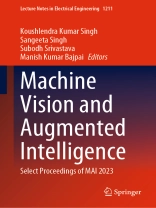This book comprises the proceedings of the International Conference on Machine Vision and Augmented Intelligence (MAI 2023). The conference proceedings encapsulate the best deliberations held during the conference. The diversity of participants in the event from academia, industry, and research reflects in the articles appearing in the volume. The book theme encompasses all industrial and non-industrial applications in which a combination of hardware and software provides operational guidance to devices in the execution of their functions based on the capture and processing of images. This book covers a wide range of topics such as modeling of disease transformation, epidemic forecast, COVID-19, image processing and computer vision, augmented intelligence, soft computing, deep learning, image reconstruction, artificial intelligence in healthcare, brain-computer interface, cybersecurity, and social network analysis, natural language processing, etc.
Tabella dei contenuti
Chapter 1:Ultra-Energy Efficient Reliable and Robust DLJLFET Based-PUF for Io T Devices.- Chapter 2:Dopingless JLFET Based 8TSRAM Cell Design for Enhanced Performance and Stability.- Chapter 3: Survey on robustness of deep learning techniques on adversarial attacks in WBAN .- Chapter 4: Synergizing Collaborative and Content-Based Filtering for Enhanced Movie Recommendations.- Chapter 5:Exploring Transformer-Based Approaches for Hyperspectral Image Classification: A Comparative Analysis.- Chapter 7:Deep Learning for Cognitive Task and Seizure Classification with Hilbert-Huang Transform and Variational Mode Decomposition.-Chapter 8:Tracking of Ship and Plane in Satellite Videos Using A Convolutional Regression Network with Deep Features.-Chapter 9:Tumor Detection and Analysis from Brain MRI Images Using Deep Learning.-Chapter 10:Software Maintenance Prediction Using Stack Ensemble Deep Learning Algorithms.- Chapter 11:Resource Allocation in 6G network for High-Speed Train using D2D Outband Communication.- Chapter 12:Controlling the Band-to-band Tunneling Effect in Charge Plasma Based Dopingless Transistor.- Chapter 13:Comparison of Different CIC filter architectures on the basis of a novel parameter called Noise Factor for Sigma-Delta based ADCs.- Chapter 14:The Scientific Analysis on Effective Yoga Posture Recognition Techniques.- Chapter 15:Impact of Gamma Rays on Emerging Devices for Photonic Applications.- Chapter 16:Shaft Rotation Monitoring Using Radar Signal Processing and Wavelet Transform.- Chapter 17:Slow-wave Structure Based on Inter-digital Capacitor and Its Application to Miniaturization of Gysel Power Divider.- Chapter 18:Noise Estimation and Removal in Fundus Images using Pyramid Real Image Denoising Network.- Chapter 19:Evaluation of Hybrid Encryption Method to Secure Healthcare Data.-Chapter 20:Multimodal Face Recognition System using Hybrid Deep Learning Feature.
Circa l’autore
Koushlendra Kumar Singh is currently working as an assistant professor in the Department of Computer Science and Engineering at the National Institute of Technology, Jamshedpur, India. He completed his doctoral degree and master’s program from the Indian Institute of Information Technology, Design, and Manufacturing, Jabalpur, India, in 2016 and 2011, respectively. Dr. Singh graduated in computer science and engineering from Bhagalpur College of Engineering, Bhagalpur, in 2008. He has published several papers in international refereed journals and conferences. His current research interest areas are image processing, biometrics, and different applications of fractional derivatives, computational modeling, epidemic forecasting, etc.
Sangeeta Singh is an Assistant Professor in the Department of Electronics and Communication Engineering, NIT Patna, India. Her researches interests include beyond CMOS Devices Green Electronics steep switching transistors and soft computing techniques and applications. She has been recognized as an eminent scholar in the field of Electronics & Computer Engineering. She is editing two books. She is a member of IEEE, IEEE EDS Society, IET, etc. She received her Ph.D. degree in Electronics and communication engineering from IIITDM Jabalpur, India. She has handled many research projects and more than 100 research articles are in her credit.
Dr.Subodh Srivastava is working as an Assistant Professor in the Department of Electronics and Communications Engineering, and Professor-In charge of IEEE SB NIT Patna, Bihar, India. He has around 60 publications in reputed Journals and conferences. 01 Indian Patent(Granted) and 12 Book chapters to his credit. He is a member of the IEEE, and is also connected with the Indian Society of Technical Education through life. He received projects from BIRAC, TEQIP and Well M in the field of AI and medical Image Processing. He is also the reviewer of many International Journals and Conferences. He received his Ph.D. from IIT (BHU) in 2014. His research interests include Image processing, biomedical image analysis, pattern recognition, machine learning, computer vision, and their medical applications.
Manish Kumar Bajpai is an Associate professor in the Department of Computer Science and Engineering at the National Institute of Technology Warangal. Dr. Bajpai has published over 50 publications in international journals and conferences. He has several sponsored research and consultancy projects funded by agencies such as SPARC, MHRD, DST, USIEF, ATAL, BRNS, and NVIDIA. 11 students have completed/pursuing their Ph.D. under his supervision. His areas of research are augmented intelligence, machine vision, brain-computer interface, medical imaging, and parallel algorithms design. Dr. Bajpai is a senior member of IEEE and a life member of the Indian Science Congress and Indian Nuclear Society.












